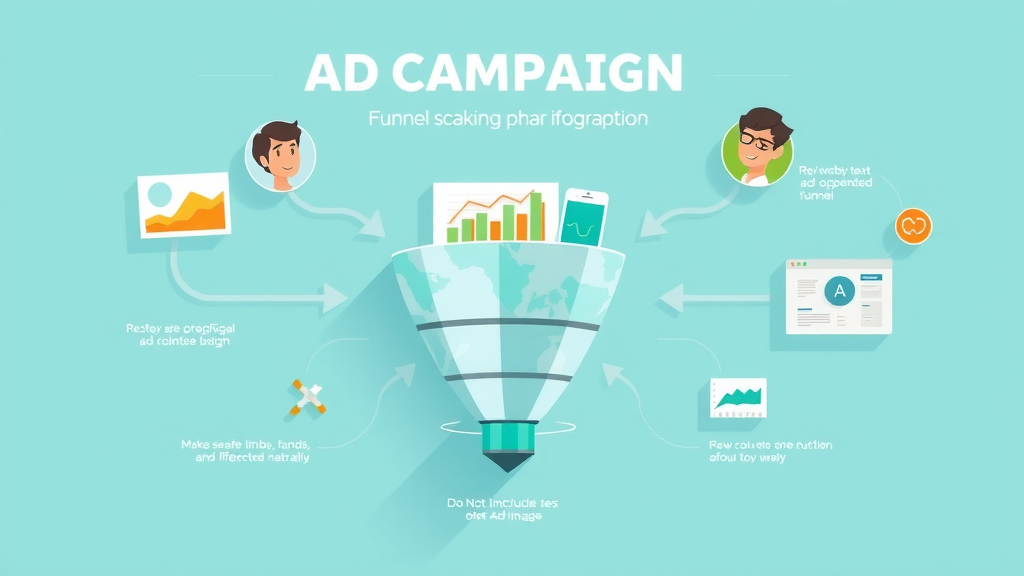Are you ready to uncover how businesses can lose up to 25% of their ad spend without smart optimization? If you’re running digital ad campaigns and not tracking every click and conversion, you might be leaving substantial growth opportunities on the table. Today, we’re diving deep into online ad optimization —the game-changer for anyone seeking breakthrough results in digital advertising. Read on to discover proven tactics, clever strategies, and the actionable steps you can take right now to transform your ad campaigns and achieve real ROI.
Why Online Ad Optimization Is the Essential Game Changer for Digital Advertising
"Did you know that businesses waste up to 25% of their ad spend without online ad optimization? Uncover the secrets to smarter campaigns and unleash your growth potential today."
Online ad optimization is redefining digital advertising success, offering a decisive edge for brands determined to thrive in hyper-competitive marketplaces. Without a precise optimization strategy, your campaigns run the risk of draining budget while failing to generate meaningful leads or conversions. Fortunately, adopting robust ad optimization methods empowers you to anticipate trends, refine messages, and allocate every dollar to where it’ll make the biggest impact.
Consider the modern digital ad landscape: You’re no longer simply buying impressions—you’re investing in outcomes. Whether your goal is increased brand awareness or a measurable uptick in conversion rate, online ad optimization brings science to the art of advertising. It allows businesses to continuously test, tweak, and tailor campaigns for steadily improving returns. If you wish to maximize ad spend efficiency and unlock higher campaign performance, understanding and applying optimization strategies is non-negotiable.

Understanding Online Ad Optimization: Definition, Purpose, and Core Benefits
Online ad optimization is the continuous process of adjusting and refining ad campaigns to maximize ROI, minimize wasted spend, and align with campaign goals. By leveraging data and technology, businesses can fine-tune their approaches in real time—testing variables like creative assets, audience segments, and bids.
The core purpose of this practice is simple—drive better results with less waste. With the digital advertising ecosystem becoming more complex daily, campaign optimization stands as the difference between stagnant and skyrocketing growth. Key benefits include improved ad performance , enhanced audience targeting precision, and increased conversion rates. In essence, smart ad optimization lets brands outpace competitors and connect with potential customers on the channels and devices where engagement is highest.
- How campaign optimization maximizes every dollar spent
- Key concepts in ad optimization for digital ad success
- Why online ad strategies impact campaign performance in modern digital marketing
Key Elements of Effective Online Ad Optimization in Advertising Campaigns
Campaign Optimization Principles: From Ad Strategy to Campaign Performance
Effective campaign optimization begins with a solid ad strategy —that is, understanding your audience, knowing your goals, and setting clear KPIs. Marketers who excel at ad optimization constantly cycle through ideation, execution, measurement, and adjustment. They use A/B testing to perfect creatives, adjust bidding strategies based on ad spend data, and continuously refine audience targeting.
It’s crucial to treat campaign optimization as an ongoing discipline. Modern tools allow for real-time data analysis, helping advertisers respond instantly if an ad campaign underperforms. By embracing iterative improvement, you ensure that each new campaign builds on previous insights, delivering ever-more impressive results across all key digital advertising metrics—from reach and engagement to conversion and return on investment.
Ad Campaign Structures for Results-Driven Ad Optimization
The structure of your ad campaign can make or break your ability to optimize for results. Hierarchical setups—using campaigns, ad sets, and individual ads—allow granular testing and precise adjustments. For example, segmenting audiences at the ad set level helps you see which groups respond best, while creative variations at the ad level let you optimize content for higher click-through and conversion rates.
Organized ad campaign structures make it easier to allocate ad spend efficiently and target audience segments effectively. Ad platforms, such as Google Ads and Facebook Ads, provide tools to clone high-performing ad sets, pause underperformers, and quickly test new variables. Proper campaign architecture accelerates campaign optimization and improves adaptability, which are both essential in a fast-evolving digital landscape.

Optimizing Ad Spend: Tactics to Increase Return on Investment
Ad spend optimization is at the heart of successful online ad campaigns. By continuously evaluating which ads, audiences, and times of day generate the highest return, marketers can reallocate budgets for maximum impact. Smart bidding strategies—such as cost-per-acquisition (CPA) or target return on ad spend (ROAS)—help advertisers get more value from each dollar.
Cutting waste is just as important as increasing reach. Using tools like bid adjustments and automated rules, you can minimize spend on low-performing segments while doubling down on what works. In turn, this boosts your overall return on investment and creates a cycle of ongoing growth for your advertising campaigns.
| Ad Platform | Strengths | Best For | Unique Feature |
|---|---|---|---|
| Google Ads | Massive reach, detailed targeting, high intent users | Search & Display Campaigns | Smart Bidding; Keyword Automation |
| Facebook Ads | Robust audience targeting, visual creatives, social integration | Brand Awareness & Social Engagement | Lookalike Audiences; Dynamic Ads |
| LinkedIn Ads | Professional targeting, B2B capabilities, native lead forms | B2B Lead Gen | Industry & Role Targeting |
| Twitter Ads | Real-time trends, hashtag targeting, conversational ads | Engagement & Event Promotion | Tweet Engagement; Trend Targeting |
The Role of Landing Pages in Online Ad Optimization and Digital Marketing
An effective landing page acts as the bridge between your digital ad and the desired action (purchase, signup, download, etc.). When optimized correctly, landing pages can double or triple conversion rates—making them a critical component of any online ad optimization plan. A cohesive journey from ad click to landing page builds trust and keeps prospects engaged.
Every element—from headline and visuals to call-to-action—must align with your ad campaign messaging. Landing page A/B testing, heatmaps, and analytics tools are vital for understanding visitor behavior and identifying where drop-offs occur. By refining these pages, you create a seamless user path that maximizes ad performance and ROI.
Creating High-Converting Landing Pages to Support Ad Campaigns
High-converting landing pages are purpose-built for a single campaign goal—reducing distractions and maximizing action. Essential elements include a compelling headline, persuasive body copy, bold visuals, and a prominent call-to-action button. Consistency between the ad creative and landing page inspires confidence and increases conversion rate .
Utilizing trust signals (testimonials, guarantees, secure badges), minimizing form fields, and ensuring lightning-fast load times are all proven tactics. Furthermore, continual A/B testing of layout, color, wording, and images can uncover surprising ways to lift ad campaign conversion rates. The quality of your landing page directly affects the efficiency of your broader digital marketing efforts.

Integrating Landing Page Optimization with Campaign Opti Tactics
Seamlessly connecting landing page optimization with your overarching campaign opti approach ensures that every step of the ad journey is data-driven. Use tools like Google Analytics, heatmaps, and session recordings to monitor how users interact with landing pages, then feed these insights straight back into your campaign strategies.
Regular collaboration between marketing and web development teams can significantly enhance ad performance . Make landing page tweaks based on live feedback from campaigns—such as modifying CTAs for clarity, optimizing mobile usability, or personalizing content for ad segments. This cyclical, collaborative approach is vital for sustainable improvement in both conversion and overall campaign performance .
Audience Targeting and Segmentation in Online Ad Optimization
One of the hallmarks of online ad optimization is laser-focused audience targeting . Rather than deploying generic messages, advertisers can leverage demographic, behavioral, and psychographic data to deliver hyper-relevant campaigns. This targeted approach not only lifts conversion rate but also stretches ad budgets even further by reserving spend for high-potential customer segments.
Advanced segmentation—such as retargeting website visitors, attracting new lookalike audiences, or isolating users at different buying stages—powers rapid learning and accelerated campaign optimization . Marketers should continually analyze audience data and adapt messaging, creative, and offers based on performance signals from each segment.
Best Practices for Using Audience Targeting in Ad Optimization
Start with clear campaign goals and define your ideal target audience profiles. Use platform-provided targeting features to segment by age, interests, location, online behavior, and more. Layered targeting strategies—combining interests with exclusion filters—ensure you reach only the most relevant users with each ad campaign .
Frequent analysis is essential. Monitor engagement and conversion data by segment, and routinely update your audience targeting criteria to reflect shifts in behavior and platform trends. Smart use of first-party data, CRM integrations, and retargeting lists can further personalize ads and drive loyal repeat action—drastically improving ad performance .

Leveraging Ad Platforms and Tools for Better Campaign Optimization
Leading ad platforms—Google Ads, Facebook Ads, LinkedIn Ads, and others—offer powerful optimization features. Automated bidding, AI-driven ad creative, and granular analytics enable marketers to fine-tune campaigns at every stage. Connect all your ad platforms to centralized dashboards for cross-channel campaign performance insights.
Invest in third-party tools as needed to gain deeper visibility and automation. Examples include analytics platforms, dynamic creative optimization (DCO) tools, and attribution software. The combination of platform-native capabilities and external digital marketing tech helps marketers execute sophisticated, multi-faceted ad optimization strategies for every advertising campaign .
Online Ad Optimization for Brand Awareness and Performance Marketing
Finding the right balance between brand awareness and conversion-focused campaigns is a hallmark of world-class online ad optimization . While performance marketing aims for direct ROI (clicks, leads, sales), brand-focused tactics build trust and top-of-mind recall. The best strategies combine the two—generating immediate results while sowing seeds for long-term growth.
By orchestrating campaigns that sequence awareness, consideration, and decision-making, advertisers can ‘warm-up’ their target audience and guide them smoothly to action. Integrated reporting and attribution tools enable brands to measure both short- and long-term impact, ensuring no effort is wasted along the digital journey.
How to Balance Brand Awareness With Conversion-Focused Advertising Campaigns
Begin by defining objectives—do you need to boost recognition among a new market, or drive immediate sign-ups? Segment your ad campaigns accordingly: run broad-reach creative for brand awareness , and retarget engaged users with conversion-centric messaging and optimized landing pages.
Many ad platforms now allow for cross-campaign retargeting and automated audience sequencing. Analyze which combinations deliver the greatest lifetime value, and split budgets proportionally based on observed ad performance . Continual optimization will help you find the sweet spot for your unique audience and business model.

Measuring Ad Performance for Campaign Optimization
"Success in digital advertising is no longer a guessing game. Online ad optimization empowers you to turn data into decisive action for every ad campaign."
Clear, actionable measurement is a foundation of effective ad optimization . Use ad platform analytics, Google Analytics, and dedicated attribution tools to track every click, view, and conversion across your campaigns. Focus on meaningful metrics such as return on investment , cost per acquisition, and conversion rate, alongside engagement indicators.
Schedule regular performance reviews to spot winning trends and flag underperformers. Present campaign insights visually for easier buy-in from stakeholders and decision makers. Make immediate adjustments based on real-time measurement to keep optimizing your digital ad campaign for peak efficiency and lasting results.
Tools and Technologies for Efficient Online Ad Optimization
Cutting-edge digital marketing relies on a mix of native platform tools and advanced third-party solutions for superior ad optimization . Choosing the right toolkit can yield faster insights, more automation, and ultimately, better campaign performance .
Start by using platform-specific features—like Google Ads’ Smart Bidding and Facebook’s Automated Rules. Add specialized tools for enhanced analytics, A/B testing, and creative personalization. The next-level efficiency comes from integrating these services into a unified reporting and automation ecosystem, powered by APIs and data connectors.
Best Ad Platforms and Digital Marketing Tools for Campaign Optimization
When selecting ad platforms , consider where your audience spends their time—and which platforms offer the best mix of automation, targeting, and analytics. Google Ads and Facebook Ads are popular choices for their flexible targeting and intelligent optimization features. LinkedIn Ads are optimal for B2B ad campaigns targeting specific industries or job roles.
Top digital marketing tools include Unbounce and Instapage for landing page A/B testing, SEMrush for competitive insight, and Google Analytics for tracking end-to-end user journeys. Automation tools like Zapier or HubSpot further streamline your campaign opti cycle by syncing data and triggering actions based on real-time conditions.
Automations and AI in Ad Optimization: Smarter Ad Campaigns for the Future
The future of online ad optimization is automated and data-driven. AI-powered tools can predict trends, adjust bids, and even create bespoke ad creatives in seconds. Automations in ad platforms allow for continuous, hands-off campaign optimization , while machine learning models identify the highest-propensity users to target.
Firms that embrace automation and AI gain a distinct edge—not only freeing up time but achieving ever-finer tuning with each campaign cycle. To stay ahead, include AI-driven recommendations and automations as core parts of your ad optimization workflow, allowing you to adapt rapidly in an ever-evolving digital advertising landscape.
Case Studies: Boosting Campaign Performance Through Online Ad Optimization
Real-world examples bring the impact of online ad optimization to life. Consider a retail client who slashed cost-per-lead by 40% simply by isolating low-ROI audience segments and reallocating budget to best-performers. Another brand doubled its sales by A/B testing landing pages and leveraging retargeted dynamic product ads.
These successful advertising campaigns demonstrate the compound effect of tiny ongoing improvements, from creative tweaks to bid adjustments and structured audience testing. Meticulous measuring and a willingness to act quickly are the real drivers behind such standout results in digital marketing .
Real-World Examples of Advertising Campaigns Enhanced by Ad Optimization
A B2B SaaS provider increased demo sign-ups by using LinkedIn Ads’ detailed industry targeting. By analyzing CRM feedback and optimizing based on conversion rates, they halved their cost-per-lead in a single quarter. Meanwhile, an e-commerce retailer split-tested Facebook Ad creatives, ultimately boosting ROAS by 67% after identifying the imagery and headlines that best resonated with their core audience.
One nonprofit organization found that splitting their ad campaign into mobile and desktop-specific paths—and optimizing each landing page with tailored calls-to-action—delivered 125% more completed donations compared to their previous broad-approach campaigns.
Lessons Learned from High-Performing Online Ad Campaigns
The most successful ad campaigns share a few traits: continuous testing, relentless focus on audience targeting , and the courage to swiftly shift spend away from underperformers. Rigorous use of analytics and cross-functional teamwork is a constant theme, as is the willingness to pivot messaging in response to market changes and consumer feedback.
The core lesson? Online ad optimization is not a one-and-done process—it is a dynamic, always-evolving discipline that must be embedded into every facet of digital marketing execution.
Step-by-Step Tutorial: How to Begin Online Ad Optimization Right Now
- Define campaign goals and KPIs: Establish what success looks like—impressions, clicks, leads, or sales—and choose core metrics for measurement.
- Set up ad platforms and targeting: Select your channels, upload creatives, and use segmented audience targeting based on your ideal customer profiles.
- Design and test landing pages: Build custom landing pages aligned with each ad campaign and run A/B tests for headlines, visuals, and calls to action.
- Monitor campaign performance: Use analytics to track key metrics such as conversion rate, cost-per-click, and return on ad spend. Adjust budgets, bids, and creatives accordingly.
- Implement continual campaign opti tactics: Routinely review data. Apply new findings, run additional tests, and automate what you can for maximum efficiency.
People Also Ask
What is advertising optimization?
Advertising optimization involves using data and analytics to improve the effectiveness and efficiency of advertising campaigns. This process includes adjusting ad placements, creative elements, audience targeting, and bidding strategies to maximize desired outcomes—such as conversions and return on investment—while minimizing wasted ad spend. The ultimate goal is to make every advertising dollar count.
What is Google ad Optimization?
Google ad optimization refers to the practice of enhancing Google Ads campaigns through strategies like keyword refinement, smart bidding, negative keywords, ad extensions, and A/B testing. Advertisers can also use Google’s automation features to drive better performance, ensuring that ads reach high-intent audiences and generate higher click-through and conversion rates for any given campaign.
How do I optimize paid ads?
To optimize paid ads, start by clearly defining your objectives and tracking the right metrics. Test multiple versions of your ads (creatives and copy), segment audiences, and use automated bidding strategies provided by the ad platforms. Consistently review performance data, shift budgets to best-performing variations, and regularly refine your landing pages to improve conversion rates and boost return on ad spend.
What is an example of campaign optimization?
An example of campaign optimization could involve a retailer who identifies that their ads perform better with women ages 25-34 in urban areas. By reallocating budget to this demographic, tweaking ad messaging, and optimizing landing pages for mobile devices, the retailer increases sales, lowers cost-per-acquisition, and sees a significant uptick in campaign performance—all through continuous optimization and data-driven decision-making.
Expert FAQ: Online Ad Optimization for Ad Campaign Excellence
- How often should campaign optimization be performed? Campaign optimization should be continuous. Review performance at least weekly, but check critical metrics daily during high-traffic periods or important promotions to catch issues and optimize in real-time.
- What metrics should I monitor in ad optimization? Track metrics such as click-through rate, conversion rate, cost per acquisition, return on ad spend (ROAS), and overall campaign ROI. Monitoring these indicators helps you gauge effectiveness and adjust tactics as necessary.
- Is online ad optimization suitable for small businesses? Absolutely. Small businesses often benefit the most from smart ad optimization, as it ensures limited budgets are focused on the most promising segments and ad creatives, delivering the greatest return for each dollar spent.
- Which ad platforms are best for campaign opti and scaling? Google Ads and Facebook Ads are top choices due to their robust targeting, automation, and analytics features. However, platforms like LinkedIn Ads (for B2B) or Twitter Ads (for events and trends) can also be effective, depending on your goals and audience.
Checklist: What You'll Learn About Online Ad Optimization
- Essentials of campaign optimization and digital ad performance
- How to maximize ROI with ad optimization
- Step-by-step actions for optimizing ad campaigns
- Tools and technologies that power smart advertising
Summary of Online Ad Optimization Strategies to Achieve High-Impact Results
- Refine audience targeting continuously
- Integrate landing page optimization
- Leverage data-driven ad creatives
- Prioritize campaign performance monitoring
Ready to Unlock Your Next-Level Ad Campaign? Call for Professional Online Ad Optimization
Ready to transform your digital advertising and crush your campaign goals? Call us today! 908 520-0095 and take the first step toward a smarter, higher-impact ad strategy!
 Add Row
Add Row  Add
Add 



Write A Comment